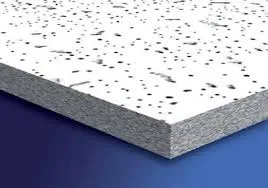8 月 . 13, 2024 23:22 Back to list
Understanding the Benefits and Applications of Mineral Fiber Acoustic Ceiling Solutions for Improved Sound Control
Understanding Mineral Fiber Acoustic Ceilings
Mineral fiber acoustic ceilings have become a popular choice in commercial and residential spaces due to their effective sound-absorbing properties and aesthetic versatility. These ceilings, primarily made from mineral fibers such as fiberglass, can significantly enhance the comfort and utility of a space by controlling noise levels, improving acoustics, and offering numerous design options.
Composition and Characteristics
Mineral fiber ceilings are crafted from natural and synthetic minerals—primarily fiberglass, gypsum, or cellulose fibers. This blend allows for a lightweight yet durable material that can withstand humidity and temperature fluctuations. The ceilings are often treated with acoustic finishes to further enhance their sound-absorbing properties. These finishes also come in a variety of textures and colors, allowing for customization that can complement the overall design of a space.
One of the standout characteristics of mineral fiber acoustic ceilings is their ability to reduce sound reflection. This feature is particularly advantageous in settings such as offices, schools, and auditoriums where managing sound levels is crucial. By lowering reverberation times, mineral fiber ceilings help create a more pleasant and productive atmosphere. Spaces that require quiet, such as libraries and meeting rooms, benefit greatly from the sound-dampening effectiveness of these ceilings.
Benefits of Mineral Fiber Acoustic Ceilings
mineral fiber acoustic ceiling

The benefits of mineral fiber acoustic ceilings extend beyond sound absorption. They are non-combustible and help improve fire safety within a building, as they can slow the spread of flames. Moreover, many mineral fiber products are designed to resist moisture and mold growth, making them ideal for areas like kitchens and bathrooms, where moisture is prevalent.
Another significant advantage is the ease of installation and maintenance. Mineral fiber tiles or panels can be installed in standard grid systems, which simplifies both the installation process and any necessary maintenance. Cleaning is typically straightforward; most ceilings can be vacuumed or wiped without special tools, and some products are paintable, allowing for further customization over time.
Environmental Considerations
In recent years, the environmental impact of building materials has become a top priority. Many manufacturers of mineral fiber acoustic ceilings have made strides in creating eco-friendly products. Some are made from recycled materials, while others are designed to be recyclable themselves. Additionally, many mineral fiber products hold certifications such as Greenguard or LEED, indicating their low emissions of volatile organic compounds (VOCs) and overall environmental friendliness.
Conclusion
In conclusion, mineral fiber acoustic ceilings offer a harmonious blend of functionality, safety, and aesthetic appeal, making them a smart choice for various applications in both commercial and residential settings. Their sound-absorbing capabilities enhance acoustics, while their fire resistance and low maintenance needs ensure a practical solution for modern spaces. With ongoing innovations in design and environmental sustainability, these ceilings are a reliable choice for those looking to create comfortable and stylish environments. Whether you are redesigning an office, constructing a new school, or simply updating your home, considering mineral fiber acoustic ceilings can be a step towards achieving a more acoustically balanced and visually appealing setting.
-
Revolutionizing Interior Design with Ceilings t grid Suspended SystemNewsOct.29,2024
-
Revolutionizing Ceiling Design with ceiling access panel with Gypsum Tile WaterproofNewsOct.29,2024
-
Revolutionizing Interior Design with PVC Gypsum Ceiling: A Comprehensive GuideNewsOct.29,2024
-
Elevating Interior Design with High quality Mineral Fiber Ceiling TilesNewsOct.29,2024
-
Revolutionizing Interior Design with PVC Gypsum Ceiling: A Comprehensive GuideNewsOct.29,2024
-
Elevating Interior Design with High-Quality Mineral Fiber Ceiling Tiles: A Comprehensive GuideNewsOct.29,2024







